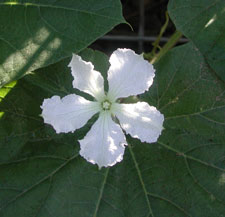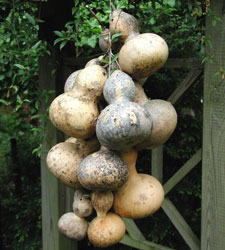Resource Library
Plant of the Week: Gourd, Bottle
The University of Arkansas System Division of Agriculture does not promote, support or recommend plants featured in "Plant of the Week." Please consult your local Extension office for plants suitable for your region.
Plant of the Week
Bottle Gourd
Latin: Lagenaria sicerari

Gardeners always wish for more room, more energy and more hours in the day to try all the possible plant choices. A group I’ve long been curious of but have not grown for want of room and sunshine are the gourds, the most common of which is the bottle gourd, Lagenaria siceraria.
Last summer, I had the opportunity to observe this vine closely at the new Botanic Garden of the Ozarks in Fayetteville.
Bottle gourds are fast growing, musky smelling annual vines belonging to the cucumber family. Originally it hailed from tropical Africa but now has become naturalized in most warm parts of the world. Their kinship to cucumbers imbues them with a green leafiness with vines easily reaching 20 feet in a couple months. Leaves are large, cordate-ovate, entire margined, soft textured and up to a foot across. The long, forked tendrils enable it to scamper up trellises with ease.
The white, five-petal, 2-inch wide flowers appear in the heat of summer. They open at dusk with female flowers pollinated by night flying moths and some beetles. To see them you must rise early for they melt away as soon as the sun strikes them.
The gourds produced by this species are extremely varied, ranging from the common bottle gourd with its dumbbell shape to those shaped as dippers, kettles, clubs, snakes, powder horns, dolphins, etc. The sizes vary from small kinds less than 6 inches long to some more than 6 feet long. Typical bottle gourds are usually around a foot in length.
Bottle gourds have a hard, relatively thin rind that becomes leathery as they dry. Though we think of them as ornamental oddities, bird houses or inviting surfaces to carve or paint, at one time they were the vegetable equivalent of the local Wal-Mart, providing people with storage vessels, cooking utensils and musical instruments.
Lagenaria gourds should be harvested late in the growing season when the rind has fully hardened. Though they will tolerate a light frost, leaving the gourds in the garden too long encourages the growth of fungi on the fruit surface that discolors the fruit.

Harvest the gourd with a couple inches of stem attached and place them in a dry, well venerated area for a few days to thoroughly dry the surface. Once surface drying is complete, place the gourds in a dry, airy, out-of-the-way location for three to six months to allow the interior of the gourd to cure. This can be judged by the light weight of the fruit and by listening to the seeds rattle about inside when shaken.
Once thoroughly dry the surface can be lightly sanded with fine sandpaper or steel wool to remove surface blemishes. They can then be shellacked, waxed with a floor polish or carved, painted or decorated in any variety of ways.
Lagenaria gourds are easy to grow in any sunny, well watered garden soil. They transplant poorly so are best seeded in place once the soil has warmed to above 65 degrees. They need a trellis, fence or a tall teepee of poles on which to climb. This species of gourds seems resistant to the squash bugs that devastate ornamental gourds in the genus Cucurbita.
By: Gerald Klingaman, retired
Extension Horticulturist - Ornamentals
Extension News - December 15, 2006
The University of Arkansas System Division of Agriculture does not maintain lists of retail outlets where these plants can be purchased. Please check your local nursery or other retail outlets to ask about the availability of these plants for your growing area.